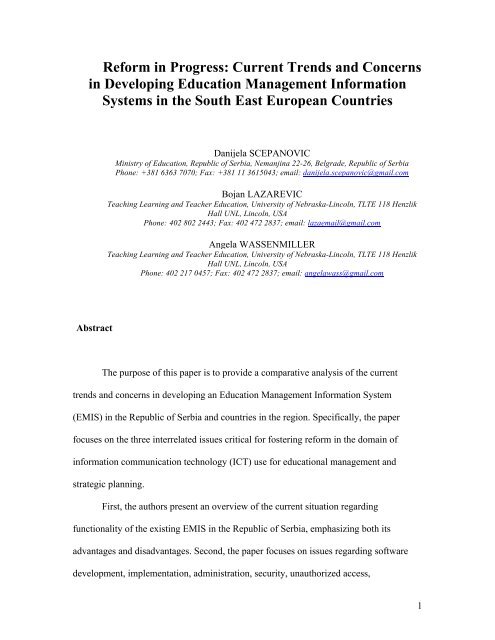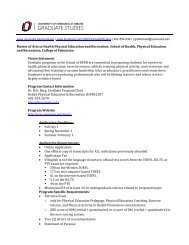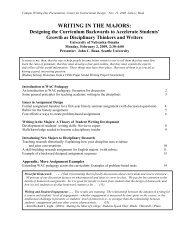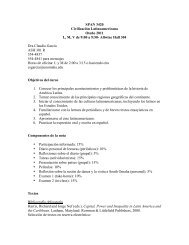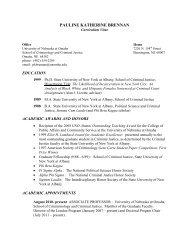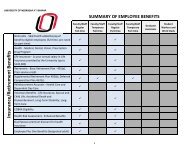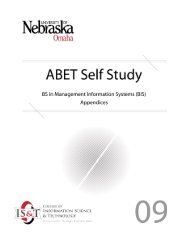Reform in Progress: Current Trends and Concerns in Developing ...
Reform in Progress: Current Trends and Concerns in Developing ...
Reform in Progress: Current Trends and Concerns in Developing ...
You also want an ePaper? Increase the reach of your titles
YUMPU automatically turns print PDFs into web optimized ePapers that Google loves.
<strong>Reform</strong> <strong>in</strong> <strong>Progress</strong>: <strong>Current</strong> <strong>Trends</strong> <strong>and</strong> <strong>Concerns</strong><br />
<strong>in</strong> Develop<strong>in</strong>g Education Management Information<br />
Systems <strong>in</strong> the South East European Countries<br />
Danijela SCEPANOVIC<br />
M<strong>in</strong>istry of Education, Republic of Serbia, Nemanj<strong>in</strong>a 22-26, Belgrade, Republic of Serbia<br />
Phone: +381 6363 7070; Fax: +381 11 3615043; email: danijela.scepanovic@gmail.com<br />
Bojan LAZAREVIC<br />
Teach<strong>in</strong>g Learn<strong>in</strong>g <strong>and</strong> Teacher Education, University of Nebraska-L<strong>in</strong>coln, TLTE 118 Henzlik<br />
Hall UNL, L<strong>in</strong>coln, USA<br />
Phone: 402 802 2443; Fax: 402 472 2837; email: lazaemail@gmail.com<br />
Angela WASSENMILLER<br />
Teach<strong>in</strong>g Learn<strong>in</strong>g <strong>and</strong> Teacher Education, University of Nebraska-L<strong>in</strong>coln, TLTE 118 Henzlik<br />
Hall UNL, L<strong>in</strong>coln, USA<br />
Phone: 402 217 0457; Fax: 402 472 2837; email: angelawass@gmail.com<br />
Abstract<br />
The purpose of this paper is to provide a comparative analysis of the current<br />
trends <strong>and</strong> concerns <strong>in</strong> develop<strong>in</strong>g an Education Management Information System<br />
(EMIS) <strong>in</strong> the Republic of Serbia <strong>and</strong> countries <strong>in</strong> the region. Specifically, the paper<br />
focuses on the three <strong>in</strong>terrelated issues critical for foster<strong>in</strong>g reform <strong>in</strong> the doma<strong>in</strong> of<br />
<strong>in</strong>formation communication technology (ICT) use for educational management <strong>and</strong><br />
strategic plann<strong>in</strong>g.<br />
First, the authors present an overview of the current situation regard<strong>in</strong>g<br />
functionality of the exist<strong>in</strong>g EMIS <strong>in</strong> the Republic of Serbia, emphasiz<strong>in</strong>g both its<br />
advantages <strong>and</strong> disadvantages. Second, the paper focuses on issues regard<strong>in</strong>g software<br />
development, implementation, adm<strong>in</strong>istration, security, unauthorized access,<br />
1
technological capacity, <strong>and</strong> technical support. Third, the authors address the<br />
organizational framework from the macro <strong>and</strong> micro st<strong>and</strong>po<strong>in</strong>ts. The authors particularly<br />
expla<strong>in</strong> the challenges that policymakers face <strong>in</strong> the process of establish<strong>in</strong>g EMIS.<br />
Furthermore, the paper provides recommendations concern<strong>in</strong>g future directions <strong>in</strong><br />
develop<strong>in</strong>g <strong>and</strong> implement<strong>in</strong>g a susta<strong>in</strong>able software platform for EMIS, as well as<br />
recommendations <strong>in</strong> regard to organizational framework. F<strong>in</strong>ally, an attempt is made to<br />
compare similarities <strong>and</strong> differences <strong>in</strong> ongo<strong>in</strong>g reform with<strong>in</strong> several countries <strong>in</strong> the<br />
region. A brief comparative overview of the development of EMIS contributes to a better<br />
underst<strong>and</strong><strong>in</strong>g of the current reform process <strong>in</strong> the use of ICT <strong>in</strong> education <strong>in</strong> the South<br />
East European (SEE) countries.<br />
Introduction<br />
The policymakers of SEE countries still face the challenge of access<strong>in</strong>g reliable<br />
data <strong>and</strong> <strong>in</strong>formation, relevant for desired education policy developments. Although <strong>in</strong><br />
many develop<strong>in</strong>g countries, the establishment <strong>and</strong> use of the susta<strong>in</strong>able EMIS is often<br />
high on the education policy agenda, it seems that the process often encounters<br />
difficulties s<strong>in</strong>ce it proves more dem<strong>and</strong><strong>in</strong>g than envisaged. With regard to design <strong>and</strong><br />
implementation of EMIS, there are three ma<strong>in</strong> areas that need reconsideration <strong>and</strong> further<br />
developments: (1) the preparation of a list of <strong>in</strong>dicators, (2) improvement <strong>in</strong> the area of<br />
EMIS management <strong>and</strong>, (3) the use of modern <strong>and</strong> appropriate technological solutions.<br />
The purpose of this paper is to provide an <strong>in</strong>-depth analysis of issues critical for<br />
successful implementation of EMIS <strong>in</strong> the Republic of Serbia. Specifically, the research<br />
2
emphasizes some of the obstacles encountered towards achiev<strong>in</strong>g its full implementation<br />
<strong>and</strong> assur<strong>in</strong>g susta<strong>in</strong>ability. An additional purpose is to give recommendations for future<br />
steps. Furthermore, this paper provides a comparative overview of the development of the<br />
education <strong>in</strong>formation management systems <strong>in</strong> several SEE countries.<br />
This study is categorized as education action research s<strong>in</strong>ce it exam<strong>in</strong>es practice<br />
<strong>in</strong> the area of EMIS design, development, <strong>and</strong> implementation with an emphasis on<br />
solutions for overcom<strong>in</strong>g system downfalls. It is based on document analysis <strong>and</strong> the<br />
results of 18 unstructured <strong>in</strong>terviews conducted with the decision makers, employees of<br />
the M<strong>in</strong>istry of Education (MoE), policy analysts, researchers, school representatives, <strong>and</strong><br />
representatives of the National Statistics Office.<br />
The ma<strong>in</strong> conclusion that emerged from the research is that EMIS is still not fully<br />
operational as it was planned at the beg<strong>in</strong>n<strong>in</strong>g of the project. EMIS should be further<br />
redesigned <strong>and</strong> rebuilt with particular focus on the three ma<strong>in</strong> areas that need<br />
developments. The concept of a new EMIS should be based on a comprehensive list of<br />
<strong>in</strong>dicators given by the national <strong>and</strong> EU strategic frameworks <strong>and</strong> accompanied by<br />
assessed needs for data at different levels of educational adm<strong>in</strong>istration (national,<br />
regional, local, school level). The susta<strong>in</strong>ability of EMIS will be assured if an EMIS unit<br />
is established, appropriately equipped, <strong>and</strong> staffed with qualified personnel. Due to the<br />
advent of technology <strong>and</strong> accessibility to a wide spectrum of software, the use of<br />
appropriate technological solutions is strongly recommended. Solutions with costs that<br />
cannot be justified <strong>and</strong> require unnecessary human <strong>and</strong> f<strong>in</strong>ancial <strong>in</strong>vestments should be<br />
avoided.<br />
3
This study is <strong>in</strong>tended to provide <strong>in</strong>formation for those <strong>in</strong>volved <strong>in</strong> design<strong>in</strong>g <strong>and</strong><br />
develop<strong>in</strong>g an EMIS. Specifically, it sheds light on obstacles that could be encountered,<br />
looked at from different angles, from the st<strong>and</strong>po<strong>in</strong>t of data users (policy makers,<br />
researchers, etc.) <strong>and</strong> data producers (educational <strong>in</strong>stitutions, EMIS staff, etc.).<br />
The Purpose of Information Management Systems <strong>in</strong> Education<br />
An efficient governance <strong>and</strong> management of education systems strongly rely on<br />
accurate, timely, easily accessible, <strong>and</strong> relevant <strong>in</strong>formation. This is usually provided by<br />
the solid <strong>in</strong>formation systems used by the education managers <strong>and</strong> planners. Lack of data<br />
often causes difficulties <strong>in</strong> develop<strong>in</strong>g effective plans, conduct<strong>in</strong>g national analyses,<br />
reviews, <strong>and</strong> evaluations, mak<strong>in</strong>g critical <strong>in</strong>terventions <strong>in</strong> certa<strong>in</strong> parts of the system,<br />
participat<strong>in</strong>g <strong>in</strong> <strong>in</strong>ternational comparisons, etc. The response for the need to easily gather<br />
<strong>and</strong> access data was often apparent throughout the development of EMISs.<br />
The importance of hav<strong>in</strong>g a functional, reliable, <strong>and</strong> susta<strong>in</strong>able EMIS was rarely<br />
under question, consider<strong>in</strong>g its foreseen benefits. Such a system assures <strong>in</strong>formed<br />
decision mak<strong>in</strong>g <strong>and</strong> represents the vital support to officials <strong>and</strong> education adm<strong>in</strong>istration<br />
needed <strong>in</strong> reform efforts <strong>and</strong> improvement of different aspects of education. Also, an<br />
EMIS is an important part of the Quality Evaluation Systems <strong>in</strong> education. The European<br />
Union (EU) documents the importance of Quality education, often stress<strong>in</strong>g it as one of<br />
the pr<strong>in</strong>cipal objectives at all levels of education <strong>in</strong> the context of the learn<strong>in</strong>g society.<br />
The Quality Evaluation <strong>and</strong> School Self-Evaluation, <strong>in</strong> particular, are seen as useful tools<br />
for track<strong>in</strong>g down students’ dropout rates (European Commission 2000). F<strong>in</strong>ally,<br />
4
accord<strong>in</strong>g to data produced by this research, a functional education management<br />
<strong>in</strong>formation system should do the follow<strong>in</strong>g:<br />
a) <strong>in</strong>crease quality through processes of plann<strong>in</strong>g, monitor<strong>in</strong>g, budget<strong>in</strong>g, <strong>and</strong><br />
evaluation at the school, local, regional <strong>and</strong> national level,<br />
b) allow better <strong>in</strong>ternational comparison of education systems,<br />
c) contribute to efficiency <strong>in</strong> perform<strong>in</strong>g adm<strong>in</strong>istrative tasks of both non-teach<strong>in</strong>g<br />
<strong>and</strong> teach<strong>in</strong>g staff employed <strong>in</strong> the education sector,<br />
d) contribute to the efficiency of public adm<strong>in</strong>istration <strong>in</strong>stitutions, particularly<br />
m<strong>in</strong>istries of education <strong>and</strong> related agencies, <strong>in</strong> preparation of reports, strategies,<br />
action plans, regulations, etc.<br />
e) assure easy access to data for different users (public adm<strong>in</strong>istration, research<br />
<strong>in</strong>stitutions, NGOs, media, parents, trade unions, <strong>and</strong> different stakeholders),<br />
f) provide <strong>in</strong>formation for build<strong>in</strong>g an efficient <strong>and</strong> fair fund<strong>in</strong>g systems, etc.<br />
Undoubtedly, build<strong>in</strong>g <strong>and</strong> ma<strong>in</strong>ta<strong>in</strong><strong>in</strong>g a functional <strong>and</strong> susta<strong>in</strong>able EMIS is still<br />
a challenge <strong>in</strong> the develop<strong>in</strong>g countries of South East Europe. The importance of<br />
develop<strong>in</strong>g it is even more significant <strong>in</strong> view of scarce f<strong>in</strong>ancial resources for<br />
educational reforms are scarce. Nevertheless, once the EMIS is <strong>in</strong> place, it represents a<br />
solid start<strong>in</strong>g po<strong>in</strong>t for educat<strong>in</strong>g policy plann<strong>in</strong>g, but new challenges do emerge: the<br />
evidence-based policy mak<strong>in</strong>g, the proper use of available data, nurtur<strong>in</strong>g the <strong>in</strong>formation<br />
shar<strong>in</strong>g culture, <strong>and</strong> <strong>in</strong>formation use. As discussed by Hua & Herste<strong>in</strong> (2003), the<br />
<strong>in</strong>formation-based decision-mak<strong>in</strong>g culture can be nurtured by <strong>in</strong>creas<strong>in</strong>g the decisionmakers’<br />
dem<strong>and</strong> for data <strong>and</strong> <strong>in</strong>formation. This k<strong>in</strong>d of dem<strong>and</strong> can be demonstrated <strong>in</strong><br />
5
the <strong>in</strong>stitutional capacity of the Plann<strong>in</strong>g <strong>and</strong> Budget<strong>in</strong>g Unit, the Monitor<strong>in</strong>g <strong>and</strong><br />
Evaluation Unit, <strong>and</strong> the Policy Research <strong>and</strong> Analysis Unit.<br />
The role of EMIS <strong>in</strong> EU <strong>in</strong>tegration processes<br />
EMIS plays a significant role <strong>in</strong> the process of EU accession for those countries of<br />
South East Europe apply<strong>in</strong>g for EU membership. Quality dimension <strong>in</strong> education is<br />
clearly stressed as an important precondition to European social <strong>and</strong> economical success,<br />
<strong>and</strong> regular monitor<strong>in</strong>g <strong>and</strong> evaluation is conducted annually. The annual reports provide<br />
detailed analysis <strong>and</strong> national statistics <strong>in</strong> each of the areas identified by the <strong>in</strong>dicators<br />
<strong>and</strong> benchmarks.<br />
The EMIS represents an important pillar <strong>in</strong> improv<strong>in</strong>g the quality of learn<strong>in</strong>g<br />
systems <strong>in</strong> the EU, creat<strong>in</strong>g a more dynamic job market, <strong>and</strong> foster<strong>in</strong>g an <strong>in</strong>clusive<br />
society. Also, the EMIS plays a significant role <strong>in</strong> provid<strong>in</strong>g equal educational<br />
opportunities for EU citizens, <strong>and</strong> it is particularly relevant for research <strong>and</strong> technological<br />
development.<br />
One practical example is participation <strong>in</strong> the European Commission’s Lifelong<br />
Learn<strong>in</strong>g Programme (2007-2013), which presents a range of actions <strong>in</strong>clud<strong>in</strong>g<br />
exchanges, study visits, <strong>and</strong> network<strong>in</strong>g activities. Projects are <strong>in</strong>tended not only for<br />
<strong>in</strong>dividual students <strong>and</strong> learners, but also for teachers, tra<strong>in</strong>ers, <strong>and</strong> all others <strong>in</strong>volved <strong>in</strong><br />
education <strong>and</strong> tra<strong>in</strong><strong>in</strong>g. There are four sub-programmes which fund projects at different<br />
levels of education <strong>and</strong> tra<strong>in</strong><strong>in</strong>g: (1) Comenius for schools, (2) Erasmus for higher<br />
education, (3) Leonardo da V<strong>in</strong>ci for vocational education <strong>and</strong> tra<strong>in</strong><strong>in</strong>g, <strong>and</strong> (4)<br />
6
Grundtvig for adult education. EMIS would be an important source of data <strong>and</strong> support<br />
for participation for pre-accession countries <strong>in</strong> this program s<strong>in</strong>ce applicants (education<br />
<strong>in</strong>stitutions, NGOs, public adm<strong>in</strong>istration <strong>in</strong>stitutions) are <strong>in</strong> constant need of data <strong>in</strong><br />
order to prepare project proposals. Also, each country should be ready <strong>and</strong> have<br />
capacities <strong>in</strong> place to monitor performance <strong>and</strong> progress of education system<br />
achievements <strong>in</strong> l<strong>in</strong>e with the series of <strong>in</strong>dicators <strong>and</strong> targets established by the EU<br />
Institutions.<br />
To date, monitor<strong>in</strong>g processes for education <strong>in</strong> the European Union is done<br />
through the Eurydice network <strong>and</strong> the Eurostat - Statistical Office of the European Union.<br />
The reliable <strong>and</strong> accurate data available from EMIS would allow those countries to<br />
become part of the Eurydice network. Eurydice was established back <strong>in</strong> the 1980’s, with<br />
the aim of provid<strong>in</strong>g policymakers <strong>in</strong> Europe with European-level analyses <strong>and</strong><br />
<strong>in</strong>formation to assist with decision-mak<strong>in</strong>g processes. So far, 31 European countries are<br />
part of the Eurydice network, which primarily focuses on the way education <strong>in</strong> Europe is<br />
structured <strong>and</strong> organized at all levels. It provides a vast source of <strong>in</strong>formation: (1)<br />
detailed descriptions <strong>and</strong> overviews of national education systems (Eurybase), (2)<br />
comparative thematic studies devoted to specific topics of community <strong>in</strong>terest (Thematic<br />
Studies), (3) <strong>in</strong>dicators <strong>and</strong> statistics (Key Data Series), <strong>and</strong> (4) series of reference<br />
materials <strong>and</strong> tools related to education, such as the European glossary, school calendars<br />
<strong>and</strong> a thesaurus on education systems (Eurydice European Unit, 2000). EMIS is also<br />
needed to feed the annual data collection of Eurostat on education, tra<strong>in</strong><strong>in</strong>g, <strong>and</strong> lifelong<br />
learn<strong>in</strong>g <strong>in</strong> EU once the pre-accession country becomes its member.<br />
7
The role of the <strong>in</strong>formation system <strong>in</strong> education is therefore crucial. It serves all<br />
levels of education, it is needed by all actors <strong>in</strong> the system, <strong>and</strong> it is essential for<br />
education policy plann<strong>in</strong>g, implementation <strong>and</strong> monitor<strong>in</strong>g processes. The sources of<br />
<strong>in</strong>formation <strong>and</strong> data <strong>in</strong> the large, complex, <strong>and</strong> dynamic systems such as the education<br />
sector are various <strong>and</strong> numerous.<br />
Research Methods<br />
With regard to a general approach <strong>in</strong> exam<strong>in</strong><strong>in</strong>g EMIS issues, this study is<br />
categorized as education action research. The ma<strong>in</strong> researcher’s <strong>in</strong>tention is to<br />
systematically exam<strong>in</strong>e educational practice <strong>in</strong> the area of EMIS, based on official<br />
documents, <strong>and</strong> to analyze the ma<strong>in</strong> project accomplishments <strong>and</strong> its determ<strong>in</strong>ants.<br />
Furthermore, the researchers reflect on how the results of current EMIS educational<br />
practice can be used to positively <strong>in</strong>fluence <strong>and</strong> improve future endeavors. This study<br />
also may be labeled as explorative qualitative research because it aims to provide an <strong>in</strong>depth<br />
underst<strong>and</strong><strong>in</strong>g of the ongo<strong>in</strong>g process of development <strong>and</strong> implementation of the<br />
EMIS <strong>in</strong> SEE.<br />
This study utilizes document analysis as its ma<strong>in</strong> research method. Accord<strong>in</strong>g to<br />
Bowen, (2009) document analysis implies a systematic procedure for review<strong>in</strong>g or<br />
evaluat<strong>in</strong>g both pr<strong>in</strong>ted <strong>and</strong> electronic documents. In other words, “document analysis<br />
requires that data be exam<strong>in</strong>ed <strong>and</strong> <strong>in</strong>terpreted <strong>in</strong> order to elicit mean<strong>in</strong>g, ga<strong>in</strong><br />
underst<strong>and</strong><strong>in</strong>g, <strong>and</strong> develop empirical knowledge” (Bowen, 2009, p.28). Furthermore,<br />
consider<strong>in</strong>g the purpose of this study, a document analysis seems to be the most adequate<br />
8
esearch method because it provides a means for track<strong>in</strong>g changes, trends, <strong>and</strong><br />
developments (Stemler, 2001). With regard to specific type of document analysis, the<br />
researchers performed primarily <strong>in</strong>terpretative analysis <strong>and</strong>, when applicable, a content<br />
analysis of data. However, document analysis was not used as a st<strong>and</strong>-alone research<br />
method but it was comb<strong>in</strong>ed with unstructured <strong>in</strong>terviews conducted with decision<br />
makers, MoE employees, policy analysts, researchers, school representatives, <strong>and</strong><br />
representatives of the National Statistics Office. A convenience sample was used to<br />
gather 18 participants.<br />
Data collection was conducted dur<strong>in</strong>g a three month period from April 2008 to<br />
June 2008 at the Republic of Serbia M<strong>in</strong>istry of Education <strong>and</strong> at other relevant<br />
<strong>in</strong>stitutions. To ga<strong>in</strong> an overall <strong>in</strong>sight <strong>in</strong>to the process of EMIS development <strong>and</strong><br />
implementation, both primary <strong>and</strong> secondary data sources were used. An <strong>in</strong>vestigation of<br />
the primary sources <strong>in</strong>cluded <strong>in</strong>ternal reports <strong>and</strong> the EMIS website, while secondary<br />
sources were expert reports, strategic papers, etc. F<strong>in</strong>ally, validity of the obta<strong>in</strong>ed data,<br />
that is the extent to which the <strong>in</strong>formation is accurate, was assessed by us<strong>in</strong>g triangulation<br />
<strong>and</strong> member check<strong>in</strong>g. Per Creswell <strong>and</strong> Plano Clark (2007), the accuracy of used data is<br />
the ma<strong>in</strong> prerequisite for ensur<strong>in</strong>g the quality of generated conclusions <strong>and</strong> study<br />
recommendations. This is even more important <strong>in</strong> the case of educational action research<br />
due to implications that study results can have on the future implementation of EMIS <strong>in</strong><br />
SEE.<br />
There is a gap <strong>in</strong> current research <strong>and</strong> practice regard<strong>in</strong>g the implementation of<br />
education management <strong>in</strong>formation systems <strong>in</strong> European countries. Although still<br />
unexplored to its full extent, many donors <strong>and</strong> creditors were will<strong>in</strong>g to <strong>in</strong>vest funds <strong>in</strong><br />
9
this project, aim<strong>in</strong>g to ensure access to better <strong>in</strong>formation for better management. “In<br />
education specifically, <strong>and</strong> focus<strong>in</strong>g on bilateral work, at any given moment <strong>in</strong> the past<br />
decade, a largish donor such as USAID would have been spend<strong>in</strong>g, very conservatively,<br />
some US $2-3 million per year on <strong>in</strong>formation systems-related development <strong>in</strong> education<br />
alone” (Crouch, 2001). Accord<strong>in</strong>g to the InfoDev website (2010), little is known about<br />
best practices <strong>in</strong> implementation of an EMIS, despite a plethora of EMIS-related projects<br />
funded by World Bank. InfoDev po<strong>in</strong>ts out the waste <strong>and</strong> <strong>in</strong>efficiency of such<br />
<strong>in</strong>vestments <strong>in</strong> the absence of mean<strong>in</strong>gful data, <strong>and</strong> calls for rigorous research on EMIS<br />
implementation <strong>and</strong> effectiveness.<br />
EMIS development <strong>in</strong> the Republic of Serbia<br />
Back <strong>in</strong> mid-2001, an <strong>in</strong>itiative was made with<strong>in</strong> the M<strong>in</strong>istry of Education <strong>and</strong><br />
Sports of Republic of Serbia (currently M<strong>in</strong>istry of Education - MoE) to beg<strong>in</strong> the<br />
development of an EMIS. This decision was backed up with the results of a wide<br />
consultancy process, conducted among teachers <strong>and</strong> adm<strong>in</strong>istration staff employed <strong>in</strong> the<br />
education sector, experts, <strong>and</strong> researchers. The ma<strong>in</strong> conclusion was that reliable <strong>and</strong><br />
accurate data on various education-related issues were miss<strong>in</strong>g. The first project on EMIS<br />
development was outl<strong>in</strong>ed at the beg<strong>in</strong>n<strong>in</strong>g of 2002. The Project was titled Education<br />
Information System, <strong>and</strong> its implementation started <strong>in</strong> 2003. It was positioned as a MoE<br />
Project <strong>and</strong> was funded by the World Bank credit arrangement. The aim of the project<br />
was to improve speed of access to data (all data would be stored <strong>in</strong> the same place), to<br />
secure cont<strong>in</strong>uity <strong>in</strong> data collection <strong>and</strong> process<strong>in</strong>g, <strong>and</strong> to open the possibility for a<br />
10
higher degree of data <strong>and</strong> <strong>in</strong>formation exchange. The <strong>in</strong>formation system was seen as the<br />
ma<strong>in</strong> source <strong>and</strong> basis for the feasibility studies that would precede the implementation of<br />
some significant solutions <strong>in</strong> special areas of education policy (M<strong>in</strong>istry of Education <strong>and</strong><br />
Sports, 2002).<br />
In early 2004, EMIS was piloted <strong>in</strong> select schools for the purpose of software<br />
test<strong>in</strong>g. At that po<strong>in</strong>t, it was expected that a database with a capacity of over 100 million<br />
pieces of data would be complete by the end of 2005. That period was also marked with a<br />
change of government, which led to the change of the M<strong>in</strong>ister of Education <strong>and</strong> Sports.<br />
A new m<strong>in</strong>ister took office <strong>in</strong> late March 2004. The reform package developed by the<br />
previous cab<strong>in</strong>et <strong>and</strong> the implementation of certa<strong>in</strong> actions were put on hold. However,<br />
project implementation was extended for 2 years <strong>and</strong> completely f<strong>in</strong>ished <strong>in</strong> mid 2007.<br />
The major achievements were listed <strong>and</strong> the ma<strong>in</strong> activities were chronologically<br />
presented <strong>in</strong> the f<strong>in</strong>al report. The authors of the report also suggested further<br />
developments <strong>in</strong> the area of capacity build<strong>in</strong>g of MoE staff, software upgrade, design of<br />
exchange of data protocol, etc (Soldic-Aleksic & Lazovic, 2007).<br />
Research f<strong>in</strong>d<strong>in</strong>gs <strong>in</strong>dicate various issues regard<strong>in</strong>g implementation <strong>and</strong><br />
functionality of an EMIS at all levels of the education system. The system has not been<br />
fully operational yet. The research f<strong>in</strong>d<strong>in</strong>gs are grouped <strong>in</strong> three ma<strong>in</strong> areas recognized as<br />
potential areas for further <strong>in</strong>vestments (developments): (1) Indicators – as the start<strong>in</strong>g<br />
po<strong>in</strong>t for EMIS development, (2) Management – as the key factor of project success <strong>and</strong><br />
susta<strong>in</strong>ability, <strong>and</strong> (3) Technology – the choice of appropriate <strong>and</strong> cost effective<br />
technological solutions.<br />
11
Indicators<br />
A start<strong>in</strong>g po<strong>in</strong>t <strong>in</strong> build<strong>in</strong>g an EMIS is a list of <strong>in</strong>dicators for the purpose of<br />
monitor<strong>in</strong>g education system performance. The list of <strong>in</strong>dicators should be developed <strong>in</strong><br />
l<strong>in</strong>e with the needs of different users at different levels of education adm<strong>in</strong>istration.<br />
Based on the list of <strong>in</strong>dicators, a list of data to be collected by EMIS should be prepared.<br />
A consultancy process is also needed as a prelim<strong>in</strong>ary/preparatory step, with the purpose<br />
of analyz<strong>in</strong>g <strong>and</strong> compil<strong>in</strong>g the needs of different users. The preparation of the EMIS list<br />
of <strong>in</strong>dicators at the beg<strong>in</strong>n<strong>in</strong>g of the project <strong>in</strong> 2003/04 was done <strong>in</strong> close cooperation<br />
with the MoE, while respect<strong>in</strong>g the needs of the users. The list of <strong>in</strong>dicators that was<br />
developed covered all essential fields, which were of an <strong>in</strong>terest to MoE as an end user at<br />
the time.<br />
The literature on EMIS recommends three groups of <strong>in</strong>dicators. An EMIS should<br />
generate <strong>in</strong>formation for users <strong>in</strong> the follow<strong>in</strong>g essential fields: (1) management <strong>and</strong><br />
adm<strong>in</strong>istration of the education system, (2) research on <strong>and</strong> plann<strong>in</strong>g of the education<br />
system (macro <strong>and</strong> micro), <strong>and</strong> (3) monitor<strong>in</strong>g <strong>and</strong> evaluation of the education system<br />
(Carrizo, Sauvageot, & Bella, 2002). Accord<strong>in</strong>gly, a master list of <strong>in</strong>dicators that were<br />
selected <strong>and</strong> approved with<strong>in</strong> the Project (2002-2007) <strong>in</strong>cluded the follow<strong>in</strong>g items:<br />
a) Macroeconomic <strong>in</strong>dicators. The follow<strong>in</strong>g belong to this group of <strong>in</strong>dicators: cost<br />
per pupil relative to GDP per capita, the share of funds allocated to education by<br />
the government relative to overall public expenditure or relative to the GDP, gross<br />
school enrolment rates accord<strong>in</strong>g to the general demographic trends <strong>in</strong> the<br />
12
country, the advancement of pupils with certa<strong>in</strong> levels of education to<br />
employment <strong>and</strong> higher education levels, etc.<br />
b) Bus<strong>in</strong>ess <strong>in</strong>dicators <strong>in</strong>clude: average revenues <strong>and</strong> expenditures by type, the cost<br />
of teach<strong>in</strong>g per pupil, the cost of teach<strong>in</strong>g by subject, average costs of repair<strong>in</strong>g<br />
<strong>and</strong> ma<strong>in</strong>ta<strong>in</strong><strong>in</strong>g school premises, costs by school <strong>and</strong> by year <strong>in</strong> time, the quality<br />
of build<strong>in</strong>gs, facilities <strong>and</strong> equipment, etc.<br />
c) Educational <strong>in</strong>dicators will assist with assess<strong>in</strong>g the results of education <strong>and</strong><br />
analys<strong>in</strong>g the criteria for improv<strong>in</strong>g academic success. Indicators such as the<br />
follow<strong>in</strong>g belong to this group: the pupil-teacher ratio, the pass rate per grade, the<br />
fail or drop out rate by gender, pupil, <strong>and</strong> grade, pupil behaviour <strong>and</strong> conduct,<br />
teachers by gender, age, <strong>and</strong> qualification, teacher professional development, the<br />
monitor<strong>in</strong>g of various school activities, such as regular teach<strong>in</strong>g, extracurricular<br />
activities, various pupil contests, the monitor<strong>in</strong>g of pedagogical activity by<br />
school, the monitor<strong>in</strong>g of the realisation of school annual plans, etc.<br />
Based on the proposed EMIS <strong>in</strong>dicators <strong>and</strong> guidel<strong>in</strong>es, the contractors of the<br />
EMIS project <strong>in</strong> the Republic of Serbia made necessary adjustments <strong>and</strong> established an<br />
adequate project model. The EMIS model <strong>in</strong> the Republic of Serbia addressed a basic set<br />
of the five follow<strong>in</strong>g components: (1) pupil database, (2) database of school employees,<br />
<strong>in</strong>clud<strong>in</strong>g both teach<strong>in</strong>g <strong>and</strong> non-teach<strong>in</strong>g staff, (3) database on school build<strong>in</strong>gs <strong>and</strong><br />
equipment <strong>in</strong> schools, (4) the f<strong>in</strong>ancial component related to account<strong>in</strong>g, the preparation<br />
of the annual payroll budget <strong>in</strong> accordance with the adequate legislation, <strong>and</strong> (5) the<br />
analytical framework for prepar<strong>in</strong>g the new formula for school f<strong>in</strong>anc<strong>in</strong>g based on perpupil<br />
f<strong>in</strong>anc<strong>in</strong>g (Kovac-Cerovic, et al., 2004).<br />
13
Research conducted <strong>in</strong> 2008 revealed that databases were not yet filled <strong>in</strong> with<br />
data. The data entry process encountered various difficulties. In June 2007, data from<br />
1,472 primary <strong>and</strong> secondary schools were available out of total of 1,648 schools, which<br />
is about 90% of the total school number. Also, the schools did not fill <strong>in</strong> all the data that<br />
was required. The module on school build<strong>in</strong>gs <strong>and</strong> equipment <strong>in</strong> schools rema<strong>in</strong>ed empty.<br />
By mid 2008, the overall availability of data was under 50% (Faculty of Electronics,<br />
2009). Research f<strong>in</strong>d<strong>in</strong>gs <strong>in</strong>dicate two possible reasons for the relatively low availability<br />
of data. First, the EMIS was perceived not as a useful tool, but as an additional burden to<br />
schools s<strong>in</strong>ce it didn’t replace the exist<strong>in</strong>g procedures of data collection <strong>and</strong> report<strong>in</strong>g.<br />
Second, schools didn’t have clear <strong>in</strong>structions about their role <strong>in</strong> its update <strong>and</strong><br />
ma<strong>in</strong>tenance (the job description of an employee responsible for data submission,<br />
work<strong>in</strong>g hours needed for the job, yearly calendar of data entry, deadl<strong>in</strong>es, etc).<br />
Although the list of <strong>in</strong>dicators <strong>and</strong> selected modules seemed appropriate at the<br />
beg<strong>in</strong>n<strong>in</strong>g of its operation, the ma<strong>in</strong> characteristic of the system proved to be miss<strong>in</strong>g, its<br />
openness for upgrade. The system was planned to be open to later modifications <strong>and</strong><br />
upgrades with new components. This is an essential requirement s<strong>in</strong>ce the list of<br />
<strong>in</strong>dicators must be periodically revised as the needs of the users may subsequently<br />
change. Due to technological <strong>and</strong> software malfunctions, the exist<strong>in</strong>g EMIS couldn’t be<br />
easily modified. The exist<strong>in</strong>g EMIS literature strongly recommends develop<strong>in</strong>g an<br />
<strong>in</strong>formation system that is flexible <strong>and</strong> adaptable to any changes <strong>in</strong> its structure (e.g.<br />
<strong>in</strong>troduction of new modules) or changes <strong>in</strong> policy objectives set by educational<br />
establishments (Powel, 2006; Wako, 2003a). Nevertheless, if a new EMIS is to be built,<br />
the start<strong>in</strong>g po<strong>in</strong>t should be the comprehensive list of <strong>in</strong>dicators. The <strong>in</strong>dicators should<br />
14
serve for regular national assessment of educational progress, monitor<strong>in</strong>g of the European<br />
goals set for 2020, as well as for <strong>in</strong>ternational comparisons. The list would serve as the<br />
basis for the precise def<strong>in</strong>ition of the type, source, <strong>and</strong> mode of data collection, while<br />
leav<strong>in</strong>g the possibility for change <strong>and</strong> updates over time.<br />
Dur<strong>in</strong>g preparation of the new list of <strong>in</strong>dicators to be monitored with<strong>in</strong> the<br />
education system of Serbia, the list of <strong>in</strong>dicators <strong>and</strong> data collected by the key<br />
<strong>in</strong>ternational organizations should be taken <strong>in</strong>to account. Those are UNESCO Institute for<br />
Statistics (UIS), the OECD, <strong>and</strong> Eurostat, who <strong>in</strong> past years founded UOE<br />
(UNESCO/OECD/Eurostat) <strong>in</strong> order to more efficiently collect <strong>in</strong>ternationally<br />
comparable data on the key aspects of the education systems of all EU member states <strong>and</strong><br />
c<strong>and</strong>idate countries. So far, the UOE has collected, processed, <strong>and</strong> published data<br />
regard<strong>in</strong>g persons enrolled, newly-enrolled, graduates, education employees, education<br />
<strong>in</strong>stitutions, <strong>and</strong> education costs. The data may be sorted by education level, gender, age,<br />
programme type (general/vocational), form (full-time/part-time), <strong>in</strong>stitution type<br />
(public/private), study area <strong>and</strong> citizenship, enrollment by region, <strong>and</strong> foreign language<br />
data (European Commission, 2002, Global Education Digest 2006, 2006).<br />
Management<br />
Typically, EMIS departments exist as <strong>in</strong>tegral parts of the M<strong>in</strong>istries of Education<br />
<strong>in</strong> other countries. F<strong>in</strong>d<strong>in</strong>gs obta<strong>in</strong>ed <strong>in</strong> this study show that management of the EMIS<br />
was a weak po<strong>in</strong>t <strong>in</strong> the process of project implementation. Furthermore, some of the<br />
15
<strong>in</strong>structions <strong>and</strong> procedures for data collection were miss<strong>in</strong>g. This research particularly<br />
revealed the need for implement<strong>in</strong>g certa<strong>in</strong> decisions:<br />
a) M<strong>in</strong>istry of Education should make a decision that the same data cannot be<br />
required from schools more than once. If the data are already available <strong>in</strong> the<br />
National Statistics Office or EMIS, they should be shared with<strong>in</strong> the <strong>in</strong>stitutions<br />
<strong>and</strong> units placed at national level. The schools are faced with the ad-hoc tasks of<br />
submitt<strong>in</strong>g certa<strong>in</strong> data several times (e.g. same data are entered <strong>in</strong>to EMIS,<br />
submitted to the National Statistics Office via their system of data collection <strong>and</strong><br />
aga<strong>in</strong> by fill<strong>in</strong>g <strong>in</strong> some forms for certa<strong>in</strong> units of the MoE).<br />
b) Data collection systems should be seriously re-designed. For <strong>in</strong>stance, the roles<br />
<strong>and</strong> responsibilities for data entry at the school level should be clearly def<strong>in</strong>ed,<br />
<strong>in</strong>clud<strong>in</strong>g deadl<strong>in</strong>es for transmission of data, time periods <strong>and</strong> formats <strong>in</strong> which<br />
data need to be produced, <strong>and</strong> other quality requirements.<br />
c) The policy of dissem<strong>in</strong>ation <strong>and</strong> distribution of <strong>in</strong>formation produced by the<br />
EMIS unit should be outl<strong>in</strong>ed <strong>and</strong> adopted (e.g. access to data as well as right to<br />
access by different users should be regulated with certa<strong>in</strong> policies <strong>and</strong><br />
procedures).<br />
d) Cooperation with the National Statistics Office should be strengthened <strong>in</strong> order to<br />
avoid duplication of tasks, ease the collection <strong>and</strong> exchange of data, <strong>and</strong> def<strong>in</strong>e<br />
the same methodology.<br />
e) MoE should precisely def<strong>in</strong>e technical <strong>and</strong> organizational requirements for each<br />
school as a precondition for the entry of data <strong>in</strong>to the system.<br />
16
f) The EMIS should be designed <strong>in</strong> a way that covers the whole system of<br />
education. It should <strong>in</strong>clude preschool education, pupil dormitories, <strong>and</strong> other new<br />
modules based on def<strong>in</strong>ed <strong>in</strong>dicators.<br />
The ma<strong>in</strong> recommendation is to conduct a functional analysis <strong>and</strong> to def<strong>in</strong>e long-term <strong>and</strong><br />
short-term human <strong>and</strong> material resource needs. As discussed by Powel (2006) <strong>and</strong> Wako<br />
(2003b), the basic preconditions for conduct<strong>in</strong>g a susta<strong>in</strong>able EMIS <strong>in</strong>clude adequate<br />
f<strong>in</strong>ancial <strong>and</strong> technical support, <strong>and</strong> <strong>in</strong>volvement of high quality experts.<br />
Technology<br />
After exam<strong>in</strong><strong>in</strong>g the technological solution <strong>and</strong> <strong>in</strong>terview<strong>in</strong>g the IT experts <strong>and</strong><br />
school representatives that could relate their work to EMIS, we came to the conclusion<br />
that some of the technological issues also emerged as unfavorable. A major drawback<br />
was that EMIS was designed as a client – server solution <strong>in</strong>stead of be<strong>in</strong>g a web-based<br />
application. The client-server solution for EMIS caused difficulties for its adm<strong>in</strong>istration,<br />
ma<strong>in</strong>tenance <strong>and</strong> development. In addition, the system was not susta<strong>in</strong>able, as the<br />
<strong>in</strong>troduction of new modules <strong>and</strong> new functionalities would be costly. Significant human<br />
<strong>and</strong> material resources were needed <strong>in</strong> order to keep such a system runn<strong>in</strong>g. Also, such a<br />
system requires the schools to be additionally equipped <strong>and</strong> staff further tra<strong>in</strong>ed. The<br />
schools are rarely equipped with the newer generation computers (e.g. <strong>in</strong> Kragujevac<br />
county there are 48 Primary schools, only 10 schools have modern computers). The<br />
outdated computers (Pentium II <strong>and</strong> III) don’t have the sufficient capacity to run EMIS<br />
software <strong>in</strong>stalled <strong>in</strong> schools. Furthermore, when a local database is filled <strong>in</strong> with large<br />
17
number of data, the EMIS software becomes unstable <strong>and</strong> nonfunctional. For<br />
adm<strong>in</strong>istration <strong>and</strong> upgrade of EMIS software, a certa<strong>in</strong> level of IT knowledge <strong>and</strong> skills<br />
is needed at the school level. Such capacities are not <strong>in</strong> place <strong>and</strong> it would be very costly<br />
<strong>and</strong> unjustified to <strong>in</strong>vest <strong>in</strong> this type of tra<strong>in</strong><strong>in</strong>gs. F<strong>in</strong>ally, the user <strong>in</strong>terface (application<br />
w<strong>in</strong>dows viewed by the users) also proved problematic. It was not user-friendly <strong>and</strong><br />
accustomed to the needs of average users. The process of data entry by school personnel<br />
would be easier if the user <strong>in</strong>terface was better designed.<br />
There were significant software flaws, which h<strong>in</strong>dered daily use at the school<br />
level but also opened the question of quality of data. The system showed that data were<br />
successfully entered at the school level, but they were miss<strong>in</strong>g <strong>in</strong> a database. The new<br />
school year often couldn’t be opened (to start data entry for that year), <strong>and</strong> the field<br />
pupils <strong>in</strong> a new school year <strong>in</strong> some cases were miss<strong>in</strong>g. When a large number of data<br />
was entered, the program was very slow. The pupils who left school could not be deleted<br />
from the total number of pupils <strong>in</strong> a given school. When reports on marks were prepared,<br />
the marks were for some reason multiplied by two (<strong>in</strong>stead of mark 5 the pupil had 10).<br />
To make matters worse, at some po<strong>in</strong>t the program would stop work<strong>in</strong>g <strong>and</strong> it had to be<br />
<strong>in</strong>stalled aga<strong>in</strong>.<br />
Based on this study’s f<strong>in</strong>d<strong>in</strong>gs, the development of a new software solution is<br />
recommended. Upgrad<strong>in</strong>g the exist<strong>in</strong>g EMIS cannot be f<strong>in</strong>ancially justified. Instead of a<br />
client – server architecture, the more appropriate solution would be the three-layer<br />
application (or other solution based on current technological development). With<strong>in</strong> a new<br />
solution, it is recommended to establish one central server where the new software <strong>and</strong><br />
the new database would be <strong>in</strong>stalled. Access to this server would be assured via Internet<br />
18
or local network (with<strong>in</strong> the M<strong>in</strong>istry) for all users via Internet browser <strong>in</strong>stead of through<br />
client application, as previously was the case. We also recommend preparation of a<br />
concept paper/document which would clarify all technical issues associated with ICT<br />
<strong>in</strong>frastructure <strong>in</strong> order to assure efficient use <strong>and</strong> susta<strong>in</strong>ability. The ma<strong>in</strong> advantages of<br />
newly developed software based on a modern concept are:<br />
a) Updates of the new software would be performed at the central server <strong>in</strong>stead of<br />
on thous<strong>and</strong>s of computers <strong>in</strong> all schools. Therefore, costs <strong>and</strong> the need for<br />
technical support would be significantly downsized.<br />
b) When access<strong>in</strong>g the new system at the school level, it would not be necessary to<br />
have a computer of a new generation.<br />
c) New software would offer a more user-friendly <strong>in</strong>terface . Users would simply<br />
need to pass a basic computer skills tra<strong>in</strong><strong>in</strong>g <strong>and</strong> a few hours of self-<strong>in</strong>struction<br />
(thorough the use of a manual).<br />
d) Users could access the Internet via different methods (MoE Project Centre, 2008).<br />
Dur<strong>in</strong>g preparation of new software, the use of the OpenEMIS should be<br />
considered. This is the program developed by UNESCO as a support to develop<strong>in</strong>g<br />
countries to create <strong>and</strong> ma<strong>in</strong>ta<strong>in</strong> an EMIS. OpenEMIS is composed of two modules,<br />
EMIS Builder <strong>and</strong> EMIS User. EMIS Builder allows database adm<strong>in</strong>istrators to adapt the<br />
generic tool to the specific characteristics of the national education system, to customize<br />
the components of the <strong>in</strong>formation system, <strong>and</strong> to create data entry forms. EMIS User<br />
enables data entry <strong>and</strong> queries, <strong>and</strong> the production of reports, charts, <strong>and</strong> <strong>in</strong>dicators<br />
(UNESCO, 2006a, UNESCO, 2006b).<br />
19
Experiences <strong>in</strong> the Region<br />
Implementation of an EMIS <strong>in</strong> SEE countries face common issues. Document<br />
analysis reveals that shar<strong>in</strong>g the experiences <strong>and</strong> common concerns regard<strong>in</strong>g<br />
implementation of an EMIS may be beneficial for all agencies <strong>in</strong>volved <strong>in</strong> EMIS projects.<br />
The follow<strong>in</strong>g brief overview shows key features of ongo<strong>in</strong>g implementation of<br />
education <strong>in</strong>formation management systems <strong>in</strong> several countries <strong>in</strong> SEE.<br />
Accord<strong>in</strong>g to the report of the M<strong>in</strong>istry of Education, Science, Culture <strong>and</strong> Sports<br />
Bosnia <strong>and</strong> Herzegov<strong>in</strong>a, Federation of Bosnia <strong>and</strong> Herzegov<strong>in</strong>a, Tuzla Kanton, an EMIS<br />
is already <strong>in</strong> use <strong>in</strong> all primary <strong>and</strong> secondary schools. The system was developed <strong>in</strong> 2002<br />
<strong>and</strong> is be<strong>in</strong>g used at the school level <strong>and</strong> at the level of the M<strong>in</strong>istry for purposes of<br />
plann<strong>in</strong>g, monitor<strong>in</strong>g <strong>and</strong> evaluation, human resource management, <strong>and</strong> <strong>in</strong>troduction of<br />
new pedagogic st<strong>and</strong>ards. In 2009, the M<strong>in</strong>istry was able to use data from the M<strong>in</strong>istry of<br />
F<strong>in</strong>ance to calculate teacher salaries <strong>and</strong> to l<strong>in</strong>k their database with the EMIS system. In<br />
the same year, the decision was made to upgrade the system s<strong>in</strong>ce is was not accessible<br />
onl<strong>in</strong>e for wider users. Also, the project called E-Diary (School Diary Application)<br />
should be developed <strong>and</strong> <strong>in</strong>tegrated with the exist<strong>in</strong>g EMIS system. In 2010, the<br />
<strong>in</strong>formation system will be extended with the module for data collection from the system<br />
of higher education (Hadzic, 2004).<br />
Accord<strong>in</strong>g to the report of the M<strong>in</strong>istry of Education <strong>and</strong> Science, Republic of<br />
Montenegro, the Ma<strong>in</strong> project on Montenegr<strong>in</strong> Educational Information System<br />
(MEMIS) development was adopted <strong>in</strong> 2004. So far, three complementary <strong>in</strong>formation<br />
systems exist for use <strong>in</strong> education at different levels. There is a need to <strong>in</strong>tegrate three<br />
20
databases <strong>in</strong>to one Integrated Educational Information System. One exist<strong>in</strong>g database<br />
conta<strong>in</strong>s data on students <strong>and</strong> employees at the level of higher education. A second is<br />
devoted to monitor<strong>in</strong>g processes at the levels of primary <strong>and</strong> secondary education. A third<br />
database is for collect<strong>in</strong>g basic statistical data from all levels of education, but there is a<br />
need to improve data collection systems <strong>and</strong> to develop a modern web-based EMIS. It<br />
was envisaged that project MEMIS will allow more efficient education management <strong>and</strong><br />
monitor<strong>in</strong>g. The project is still <strong>in</strong> the development phase <strong>and</strong> is considered as complex<br />
<strong>and</strong> dem<strong>and</strong><strong>in</strong>g project. In 2009, the first version of the software was presented at the<br />
Meet<strong>in</strong>g of the M<strong>in</strong>istries ICT Council. The application was developed by the Faculty of<br />
Science, Podgorica <strong>and</strong> conta<strong>in</strong>ed modules such as School Diary, F<strong>in</strong>ances, Human<br />
Resources, Pupils, Adm<strong>in</strong>istration, etc. It is planned to start the test<strong>in</strong>g phase <strong>and</strong> tra<strong>in</strong><strong>in</strong>g<br />
of users for the MEMIS as well as to <strong>in</strong>tegrate all databases <strong>in</strong>to one unique database for<br />
the whole system of education (M<strong>in</strong>istry of Education <strong>and</strong> Science, 2007).<br />
The M<strong>in</strong>istry of Education, Science <strong>and</strong> Sports, Republic of Croatia, reported that<br />
the Integrated System for Management of St<strong>and</strong>ardized Data (e-Matica) was launched <strong>in</strong><br />
2005 <strong>and</strong> became operational <strong>in</strong> the 2006/2007 school year. The e-Matica system is the<br />
<strong>in</strong>tegrated database on st<strong>and</strong>ardized data from primary <strong>and</strong> secondary schools (schools,<br />
employees, pupils, programs, etc) <strong>and</strong> is considered a start<strong>in</strong>g project for the future<br />
development of an education management <strong>in</strong>formation system (M<strong>in</strong>istarstvo znanosti,<br />
obrazovanja i sporta, 2007).<br />
For the section on experiences <strong>in</strong> the region, the authors had to rely on officially<br />
published reports by the respective <strong>in</strong>stitutions <strong>and</strong> were not able to conduct field<br />
research. There is an assumption that field research will offer more accurate <strong>and</strong> realistic<br />
21
<strong>in</strong>formation on the problems these countries encounter dur<strong>in</strong>g EMIS development, as was<br />
case for the Republic of Serbia.<br />
Conclusion<br />
In some South East European countries, due to slow <strong>and</strong> less successful EMIS<br />
development, basic statistical <strong>in</strong>formation of outst<strong>and</strong><strong>in</strong>g importance is still miss<strong>in</strong>g or<br />
unavailable. Based on <strong>in</strong>formation available on the process of EMIS development <strong>in</strong> four<br />
SEE countries, several conclusions can be drawn. SEE countries have recognized the<br />
need to have susta<strong>in</strong>able <strong>and</strong> reliable <strong>in</strong>formation systems <strong>in</strong> education, <strong>in</strong>itiat<strong>in</strong>g<br />
development of such systems <strong>in</strong> the last decade. For development, these countries still<br />
depend on the f<strong>in</strong>ancial resources of donors <strong>and</strong> creditors. Lack of management <strong>and</strong><br />
human resource capacities provide barriers for efficient implementation. It seems that<br />
each country has a unique approach to system development, rang<strong>in</strong>g from the approach of<br />
creat<strong>in</strong>g a big <strong>and</strong> complex project with slow <strong>and</strong>/or less successful implementation<br />
(Republic of Serbia, Montenegro) to a step-by-step approach (Republic of Croatia).<br />
EMIS development <strong>in</strong> the Republic of Serbia is still fac<strong>in</strong>g significant challenges.<br />
There is a clear need to develop <strong>and</strong> make such a system operational <strong>and</strong> susta<strong>in</strong>able for<br />
the purpose of monitor<strong>in</strong>g education system performance <strong>and</strong> faster <strong>in</strong>tegration <strong>in</strong>to the<br />
European Union. Any further <strong>in</strong>vestments should start with the careful preparation <strong>and</strong><br />
official adoption of a list of <strong>in</strong>dicators, establishment of the professional EMIS unit,<br />
development of a set of realistic procedures, the selection of up-to-date <strong>and</strong> appropriate<br />
technological solutions, etc. There is a strong recommendation not to underestimate the<br />
22
complexity of EMIS development aga<strong>in</strong> <strong>in</strong> order to avoid a waste of human <strong>and</strong> f<strong>in</strong>ancial<br />
resources.<br />
References<br />
Bowen, G. A. (2009). Document analysis as a qualitative research method. Qualitative<br />
Research Journal. 9(2), 27-40.<br />
Carrizo, L. Sauvageot, C., & Bella, N. (2003). Information tools for the preparation <strong>and</strong><br />
monitor<strong>in</strong>g of education plans, Paris, UNESCO/IIEP.<br />
Creswell, J., & Plano Clark, V. (2007). Design<strong>in</strong>g <strong>and</strong> conduction mixed methods<br />
research. Thous<strong>and</strong> Oaks, CA: Sage.<br />
Crouch, A. L. (2001). Susta<strong>in</strong>able EMIS: Who is Accountable? Research Triangle<br />
Institute (RTI), North Carol<strong>in</strong>a, USA.<br />
European Commission, (2000). European report on quality of school education: Sixteen<br />
quality <strong>in</strong>dicators. Report based on the work of the Work<strong>in</strong>g Committee on<br />
Quality Indicators. Development of Education Policies.<br />
European Commission, (2002). Education <strong>and</strong> Tra<strong>in</strong><strong>in</strong>g <strong>in</strong> Europe: diverse systems,<br />
shared goals for 2010, Brussels.<br />
Eurydice European Unit, (2000). Eurydice, the <strong>in</strong>formation network on education <strong>in</strong><br />
Europe, 20 years promot<strong>in</strong>g better underst<strong>and</strong><strong>in</strong>g of education systems. Brussels.<br />
Faculty of Electronics, (2009). The <strong>in</strong>tegrated education <strong>in</strong>formation system project.<br />
University of Belgrade, Belgrade.<br />
Global Education Digest 2006, (2006). Compar<strong>in</strong>g education statistics across the World.<br />
UNESCO Institute for Statistics, Montreal.<br />
Hadzic, Dj. (2004). Education managment <strong>in</strong>formation system. M<strong>in</strong>istry of Education,<br />
Science, Culture <strong>and</strong> Sports Bosnia <strong>and</strong> Herzegov<strong>in</strong>a, Federation of Bosnia <strong>and</strong><br />
Herzegov<strong>in</strong>a, Tuzla Kanton.<br />
Hua, H., &, Herste<strong>in</strong>, J. (2003) Education Management Information System (EMIS):<br />
Integrated data <strong>and</strong> <strong>in</strong>formation systems <strong>and</strong> their implications. Proceed<strong>in</strong>gs from<br />
23
the Annual Conference of Comparative <strong>and</strong> International Education Society, New<br />
Orleans, LA, USA.<br />
InfoDev (2010). Education Management Information Systems (EMIS): Case Studies <strong>and</strong><br />
Lessons Learned. Retrieved November 23, 2010, form<br />
http://www.<strong>in</strong>fodev.org/en/Project.5.html<br />
Kovac-Cerovic, T. et al., (2004). Quality education for all: Challenges to the education<br />
reform <strong>in</strong> Serbia. M<strong>in</strong>istry of Education <strong>and</strong> Sports, Republic of Serbia, Belgrade.<br />
M<strong>in</strong>istarstvo znanosti, obrazovanja i sporta, (2007). Pregled postignuca 2004. – 2007.<br />
Vlada Republike Hrvatske.<br />
M<strong>in</strong>istry of Education <strong>and</strong> Science, (2007). ICT Council Report. M<strong>in</strong>istry of Education<br />
<strong>and</strong> Science of Republic of Montenegro,<br />
M<strong>in</strong>istry of Education <strong>and</strong> Sports, Republic of Serbia, (2002). Quality education for all:<br />
A way to a developed society. M<strong>in</strong>istry of Education <strong>and</strong> Sports of the Republic of<br />
Serbia, Belgrade.<br />
MoE Project Centre (2008). Concept paper on Integrated Education Information System<br />
<strong>in</strong> Education (IEMIS). manuscript.<br />
Powel, M. (2006). Reth<strong>in</strong>k<strong>in</strong>g education management <strong>in</strong>formation systems: Lessons from<br />
<strong>and</strong> options for less developed countries. Cambridge Education. Cambridge.<br />
Soldic-Aleksic J. & Lazovic, N. (2007). Project component C: Development of the<br />
<strong>in</strong>formation system <strong>in</strong> education (system analysis, software development <strong>and</strong><br />
tra<strong>in</strong><strong>in</strong>g of users). unpublished MoE report (manuscript).<br />
Stemler, S, (2001). An overview of content analysis. Practical Assessment, Research &<br />
Evaluation, 7(17).<br />
UNESCO, (2006a). OpenEMIS builder: User documentation, Division of Educational<br />
Policies <strong>and</strong> Strategies.<br />
UNESCO, (2006b). OpenEMIS user start-up guide. Division of Educational Policies <strong>and</strong><br />
Strategies.<br />
Wako T. N. (2003a). Education management <strong>in</strong>formation system (EMIS): An overview.<br />
Zimbabwe, UNESCO.<br />
Wako T. N. (2003b). Education management <strong>in</strong>formation systems (EMIS): A guide for<br />
young managers. Zimbabwe, NESIS/UNESCO.<br />
24


